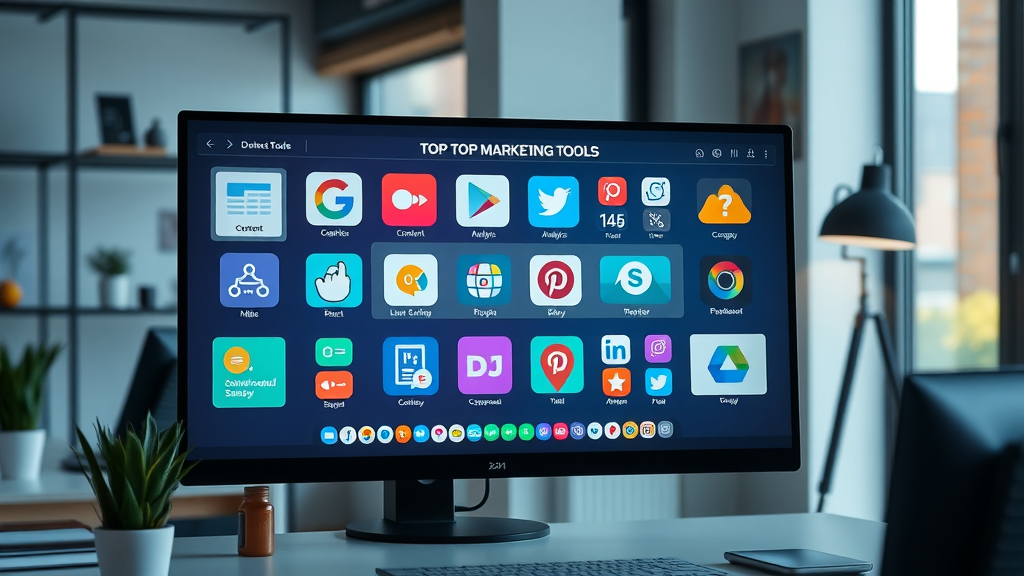Did you know that over 81% of small businesses depend on digital marketing strategies to accelerate growth and connect with new customers every year? In today’s fast-paced, digitally connected world, leaving your online presence to chance is no longer an option. Whether you run a family coffee shop or a budding tech startup, leveraging the right digital marketing tactics can mean the difference between stagnation and extraordinary results. This comprehensive guide reveals the transformational secrets of digital marketing for small businesses, packed with actionable steps, expert tips, and inspiring real-world examples. Ready to supercharge your marketing strategy and see your sales soar?
Why Digital Marketing for Small Businesses is a Game Changer: Unveiling the Numbers
"Over 81% of small businesses rely on digital marketing strategies to drive growth and reach new customers every year."
- Explore how digital marketing for small businesses reshapes the competitive landscape by leveraging marketing strategies and online presence.

The digital revolution has redefined the way small businesses attract, retain, and engage their target audience . Unlike traditional marketing, which often demands hefty budgets and yields unpredictable outcomes, digital marketing enables businesses to directly measure results, optimize campaigns, and rank higher in search results. With nearly every industry adopting online marketing, it’s now easier than ever for small businesses to compete with established giants—leveling the playing field through cost-effective , scalable solutions.
Real-world numbers back these transformations. Businesses that prioritize their online presence typically experience boosted visibility, increased website traffic, and a swifter path to sales growth. From social media engagement to data-driven campaigns, the benefits of investing in digital marketing are undeniable. Thanks to analytics and targeted efforts, small businesses can maximize ROI, ensuring that every marketing dollar is put to its best use.
In short, embracing digital marketing strategies isn’t just an option—it’s a survival necessity in today’s hyper-connected world. Success stories abound of small business owners using SEO, social media, and email marketing to drive customer engagement, reach potential customers , and carve out their slice of the market. Are you ready to join their ranks and transform your business profile?
Unlocking Success with Digital Marketing for Small Businesses: Understanding the Core Principles
- Defining digital marketing for small businesses
- Importance of marketing strategies and online presence
- Common misconceptions and mistakes
At its core, digital marketing for small businesses refers to all marketing efforts that use online channels—websites, social media, search engines, and email—to connect with potential and existing customers. The true power of digital marketing lies in its adaptability; small businesses can pivot quickly, test new platforms, and focus on the strategies that produce results.
Many business owners think digital marketing is only about having a website or running a few ads. In reality, it’s about cultivating a holistic online presence where each channel supports the other. Optimizing your business profile on each media platform and regularly engaging your audience ensures your brand remains top of mind. It’s the synergy of marketing strategies , such as content marketing and SEO, that yields increased awareness and greater trust.
Common misconceptions include the belief that only big brands can succeed online, or that digital marketing is too complex or expensive for small businesses. However, by understanding your audience, setting realistic goals, and avoiding typical pitfalls—like neglecting analytics or spreading resources too thin—any business can thrive. Embrace the fundamentals below as your springboard to marketing success.
Benefits of Digital Marketing for Small Businesses: Maximizing Impact with Effective Marketing Strategies
- Cost-effectiveness and scalability
- Reaching your target audience efficiently
- Building a strong business profile online
The primary advantage of digital marketing for small businesses is its accessibility. Even with a modest marketing budget , brands can run targeted ad campaigns, launch professional content marketing initiatives, and interact with followers across different social media platforms . Unlike traditional advertising, where costs can spiral, digital allows for granular control and optimization—providing better results for less money and the ability to scale as your business grows.
Digital marketing also enables small businesses to fine-tune their message and reach their exact target audience through channels such as Facebook, Instagram, and Google. Tools like audience segmentation and analytics provide immediate feedback, so you can respond in real time—adjusting campaigns for maximum impact. Building an engaging business profile online helps foster loyalty and create deeper relationships with customers.
Ultimately, the benefits aren’t just financial. With a solid online presence and clear marketing strategies, small businesses gain credibility, stand out in search results, and build a loyal community eager to support their journey.

Establishing Your Online Presence: Essential Digital Marketing Steps for Small Businesses
Setting Up a Professional Business Profile Across Media Platforms
- Consistent branding for your small business
- Optimizing for search engine visibility
Establishing a unified and professional business profile across all key media platforms is essential for credibility and visibility. Consistency in branding—logos, messaging, and imagery—helps your audience recognize and remember your business no matter where they find you. Use the same profile icons, color schemes, and value propositions throughout your website, social media accounts, online directories, and review sites to present a cohesive identity.
In addition to visual consistency, always provide accurate business details and keep them updated. Consider using relevant keywords when crafting your profiles, which improves discoverability and helps you rank higher in search engines . Optimize each profile with high-quality images and compelling descriptions to promote your products or services and boost your search engine visibility.

Don’t overlook platforms like Google My Business, Yelp, and LinkedIn, which are often the first touchpoints for potential customers . These listings not only improve search result rankings but can also drive foot traffic and inquiries. Small businesses that invest in a solid digital foundation consistently see greater brand awareness, trust, and engagement.
Leveraging Social Media Platforms to Expand Reach
- Choosing the best social media platform for your target audience
- Creating compelling content across social media platforms
Social media is a powerful amplifier for small business marketing. By choosing the social media platform that best fits your target audience , you maximize both reach and engagement. For instance, Instagram is great for visual storytelling and younger demographics, while Facebook appeals to a broader age range and community discussions. LinkedIn works well for B2B and professional services.
Next, focus on delivering high-value content that resonates with your audience. Use a mix of stories, short videos, polls, and live sessions to keep followers engaged and informed. Sharing customer testimonials, behind-the-scenes glimpses, and product demos builds credibility and encourages user interaction. Remember, it’s not just about posting but also fostering conversations, responding promptly, and demonstrating genuine interest in your community.
Successful social media marketing for small businesses hinges on being present where your audience spends their time and consistently offering content that entertains, informs, or solves problems. Over time, this strategy will drive brand loyalty, word-of-mouth referrals, and steady business growth.
Digital Marketing Strategies for Small Businesses: Proven Tactics That Drive Results
| Strategy | Description | Expected Outcomes |
|---|---|---|
| Content Marketing | Educate & engage your audience through value-rich content. | Stronger relationships & SEO improvement |
| Social Media Marketing | Promote services/products and interact directly with target audience. | Increased awareness & engagement |
| Influencer Marketing | Leverage trusted media figures to endorse your business. | Enhanced credibility & outreach |
| Email Marketing | Build and nurture your email list to drive conversions. | Higher repeat customer rate |
| Search Engine Optimization | Optimize your website for search engine ranking. | Greater organic traffic & visibility |
"A tailored marketing strategy can deliver an ROI of up to 400% for small businesses investing in digital marketing."
- Integrating multiple marketing efforts for unified results
- Setting SMART goals for your digital marketing campaigns

The key to unlocking results lies in embracing a combination of proven marketing strategies . Start by creating informative blog posts, how-to videos, or thought leadership pieces that address the needs of your target audience —known as content marketing . Pair this with active social media and influencer partnerships, and you’ll build a well-rounded brand presence.
Finally, use email marketing to build a dedicated email list of customers and fans, nurturing relationships long-term. Always measure results and adapt your approach. Setting SMART goals —Specific, Measurable, Achievable, Relevant, Time-bound—will give your campaigns purpose and clarity, ensuring every marketing dollar is wisely spent.
For optimal results, look for ways to integrate all your marketing efforts. Coordinate campaigns and keep your branding consistent across each touchpoint, from emails to social posts and website updates. Monitoring campaign analytics in real-time will help you adapt proactively and guide your efforts toward continued growth.
Crafting a Social Media Marketing Plan for Small Businesses
Choosing the Right Social Media Platform for Your Small Businesses
- Evaluating platforms to reach your target audience
- Building brand authority through consistent engagement
Before diving into social media campaigns, evaluate platforms such as Facebook, Instagram, X (Twitter), LinkedIn, TikTok, and Pinterest to determine which aligns with your target audience and goals. For example, B2C businesses often prioritize Instagram and Facebook, while B2B service providers focus on LinkedIn. Assess where your potential customers engage most and consider the types of content that perform best on each channel.
Once you’ve selected your core platforms, establish authority by posting consistently and interacting with your community. Respond promptly to messages and comments, participate in relevant conversations, and share valuable content—not just promotional posts. This regular engagement not only builds trust but signals to algorithms that your business profile is active and worth promoting.
Track performance metrics for each channel to know where your marketing efforts are most effective. Over time, double down where you see the best results, and consider experimenting with emerging platforms or media formats to expand your reach even further.
Content Creation and Scheduling for Social Media Success
- Types of content marketing that captivate followers
- Effective scheduling and automation tools for small businesses
High-quality content is the backbone of social media marketing . Experiment with a blend of images, short videos, infographics, tutorials, contests, and user-generated content to keep your followers engaged. Behind-the-scenes posts and customer stories humanize your brand, while polls and Q&A sessions foster direct interaction.
Use tools like Buffer, Hootsuite, or Sprout Social to schedule posts in advance, freeing your time for creativity and engagement. Developing a content calendar helps balance promotional posts with value-driven updates, ensuring consistent voice and frequency across all media platforms . Automation assists in posting at optimal times for your audience, expanding your reach even when you’re offline.
Always measure the impact of each content type and refine your approach. Pay attention to likes, shares, comments, and click-through rates to see what resonates, then optimize future campaigns based on real data and audience preferences.
Optimizing Search Engine Visibility: SEO for Small Businesses
Search Engine Optimization Essentials
- Keyword research focused on small businesses
- On-page and off-page SEO techniques
Search engine optimization (SEO) is fundamental for driving organic traffic to your website. Begin with targeted keyword research—using tools like Google Keyword Planner or SEMrush—to discover terms your target audience is actually searching for. Prioritize long-tail keywords that align closely with your products or services to stand out in search results .
Enhance your website with on-page SEO tactics: optimize meta titles and descriptions, use clean URLs, and structure your content with heading tags. Off-page strategies—such as earning quality backlinks and encouraging online reviews—help build authority in the eyes of search engines . Don’t forget to optimize images with descriptive file names and alt text for better accessibility and rankings.

Consistently monitoring your search engine rankings and making minor adjustments can yield big results over time. Remember, SEO is a long-term effort, but businesses that commit to the process often enjoy the highest number of inbound leads and cost savings on paid advertising.
Content Marketing as an SEO Driver
- Top-performing content types for digital marketing
- Encouraging user-generated content for SEO
Content is not just king—it’s the engine that powers your SEO strategy. Publishing consistent, valuable blog articles, downloadable guides, product demos, and customer success stories not only educates your audience but helps you rank higher for important keywords. Regular updates signal to search engines that your site is active and authoritative.
Encourage customers to leave reviews, share testimonials, and submit photos or stories related to your product or service. User-generated content is highly trusted by new buyers and can improve credibility and site engagement, both key ranking factors.
Track how each content type drives traffic, engagement, and conversions. Double down on what works best and continually look for fresh angles and topics to stay ahead of competitors. Consistency is what sets high-performing websites apart in search results.

Mastering Email Marketing: Building Your Email List for Small Businesses
Constructing a High-Converting Email List
- Why email marketing still delivers strong ROI
- Tactics to increase email sign-ups for small businesses
Despite the rise of social media and new media platforms, email marketing remains one of the most reliable channels for small businesses. It delivers a direct line to your audience’s inbox—driving repeat purchases and keeping your brand top of mind. The first step is to build an email list filled with high-quality, interested leads.
Tactics such as offering valuable lead magnets (discounts, guides, or exclusive content), using pop-up sign-ups, and promoting your newsletter across all media platforms ensure steady list growth. Always be transparent about what subscribers can expect, and respect privacy by following anti-spam laws. A clean, engaged list is worth more than thousands of uninterested contacts.
Over time, nurture your email list with engaging updates, special offers, and useful tips tailored to your target audience . This builds loyalty and can turn occasional buyers into long-term fans.
Crafting Effective Email Campaigns for Small Businesses
- Segmentation, personalization, and automation in email marketing
- Measuring and improving email performance
A successful email campaign goes beyond just sending newsletters. Start by segmenting your email list based on user type, past purchases, or interests. This allows you to personalize content, improving engagement and conversion rates. Automation tools like Mailchimp, Constant Contact, or HubSpot help deliver the right message at the right time.
Regularly measure campaign performance with metrics like open rates, click-through rates, and conversions. Test different subject lines, layouts, or calls to action to determine which approaches best resonate with your audience. Always update your strategies based on data—not guesses—for ongoing improvement.

By mastering segmentation, personalization, and analysis, small businesses can maximize the ROI of every email campaign—transforming casual subscribers into loyal buyers.
Budgeting your Digital Marketing Efforts: How Small Businesses Can Maximize ROI
- Assess your marketing budget and set realistic campaign expectations
- Prioritize marketing strategies with the best ROI for your business profile
- Monitor and adjust spending based on performance analytics
"Smart allocation of marketing budget is the hidden engine behind accelerated small business growth."

Every dollar counts for small businesses . Start by setting a realistic marketing budget that reflects your goals and expected outcomes. Prioritize channels that consistently deliver the best ROI, such as SEO, email marketing , and targeted social ads. Don’t spread your resources too thin—it's better to focus and excel on two or three channels than to underperform on many.
Leverage free trials and low-cost platforms to experiment with new marketing strategies before investing heavily. Track every campaign’s performance meticulously. If a strategy isn’t yielding the results you want, adjust—not just with your budget but also your messaging and approach. Small tweaks can lead to big improvements and ultimately free up resources for creative experimentation.
Through smart allocation and frequent evaluation, even businesses with modest budgets can build a strong, sustainable online presence and achieve impressive marketing results.
Measuring Results: Analytics for Digital Marketing in Small Businesses
- Identify and track the right KPIs for digital marketing success
- Use analytics tools to refine marketing strategy and efforts

Success in digital marketing for small businesses hinges on knowing which metrics matter most. Focus on key performance indicators (KPIs) relevant to your goals: website traffic, conversion rates, email open rates, social engagement, cost per lead, and overall ROI. Google Analytics, Facebook Insights, and email tool dashboards are critical resources for ongoing measurement.
Analytics aren’t just for tracking results—they’re for guiding your strategy. Use real data to determine which channels, content types, and timing resonate best with your audience. Experiment, iterate, and never be afraid to pivot when something isn’t working. This data-driven approach sets thriving businesses apart from those that stagnate.
Review your analytics regularly, set benchmarks, and celebrate growth milestones along the way. Over time, you’ll gain new insights to fine-tune campaigns and maximize every marketing effort.
People Also Ask
How can small businesses use digital marketing?
- Step-by-step actions for small businesses entering digital marketing
- Examples of successful marketing efforts
Small businesses can get started by setting up a professional website, creating business profiles on key media platforms , and choosing 1-2 marketing strategies such as social media or email marketing to focus on first. Share useful content that addresses customer needs, connect with your community, and measure results to inform future actions. Many small businesses find success with a focused approach—using digital ads, social posts, and search engine optimization to steadily build awareness and sales.
What are the 4 types of digital marketing?
- Overview: content marketing, email marketing, social media marketing, and search engine optimization
The four main types are content marketing (blogging, guides, and videos), email marketing (newsletters and triggered campaigns), social media marketing (posting and engagement on platforms like Instagram and Facebook), and search engine optimization (improving website visibility in search results). Each serves a unique purpose but works best when combined for broader reach and impact.
What are the 5 S's of digital marketing?
- Sell, Serve, Speak, Save, and Sizzle explained for small businesses
The 5 S's are: Sell (boost online sales), Serve (offer valuable information), Speak (engage with your audience), Save (reduce costs with efficient strategies), and Sizzle (create a memorable online brand). Applying these principles keeps your digital marketing focused and customer-centered.
How do beginners start digital marketing?
- Actionable steps for new small businesses to build an online presence
Beginners should begin by defining their business profile and objectives, creating or updating their website, and choosing priority channels based on where their target audience spends time. Start small—run a test campaign, join one or two social platforms, and send your first newsletter. Above all, measure everything and learn as you go.
Top Digital Marketing Tools and Resources for Small Businesses
- Best tools for content marketing and social media management
- Analytics resources suited for small business marketing strategies
- Affordable influencer marketing and search engine optimization platforms
The right marketing tools empower small businesses to manage campaigns efficiently and get more done in less time. For content marketing and social scheduling, try Buffer, Hootsuite, or Canva for easy post creation and planning. Google Analytics and Facebook Insights reveal how your efforts translate into traffic and leads.
Affordable platforms like BuzzSumo and Upfluence help you discover and manage influencer marketing campaigns within your marketing budget. For SEO, consider SEMrush, Moz, or Google Search Console to monitor rankings and find optimization opportunities.
Use these tools to streamline your strategy, measure results automatically, and stay ahead of the competition—freeing you up to focus on creativity and customer relationships.

Frequently Asked Questions on Digital Marketing for Small Businesses
- How much should small businesses spend on digital marketing? The ideal budget varies, but a general rule is allocating 7–10% of revenue to marketing, with a significant share dedicated to digital channels due to higher ROI and trackability.
- Can digital marketing replace traditional marketing strategies? For most small businesses, digital marketing can replace or at least supplement traditional strategies, offering more measurable, cost-effective ways to reach the target audience.
- Do I need to hire a professional for my digital marketing efforts? While many platforms are DIY-friendly, hiring a professional or agency can accelerate success, avoid mistakes, and free your time for core business activities.
- What is the most effective digital channel for small businesses? The answer depends on your audience and goals, but typically, SEO and email marketing drive the highest sustained ROI, with social media providing fast, broad reach.
Common Mistakes to Avoid in Digital Marketing for Small Businesses
- Ignoring search engine optimization or skipping analytics
- Overextending your marketing budget without specific goals
- Underestimating the power of influencer marketing
One of the biggest pitfalls is neglecting search engine optimization or failing to review analytics—which can lead to wasted resources and missed opportunities. Spreading your marketing budget thinly across too many tactics without defined objectives often results in poor performance. Lastly, overlooking the value of influencer marketing may mean missing out on valuable, authentic exposure. Stay focused, set goals, and let data guide your way.
Recap and Action Steps: Implementing Digital Marketing for Small Businesses
- Immediate next steps for boosting online presence
- Checklist for launching effective marketing efforts
- Proven ways to track your digital marketing success

To jumpstart your strategy today, ensure your business profile is up to date across all media platforms , select 2–3 key marketing strategies to prioritize, and establish clear goals. Launch a campaign, engage with your audience, and make analytics a regular part of your process for continual improvement. With each step, you’ll gain confidence, customer loyalty, and measurable growth.
Take Your Small Businesses Further: Personalized Digital Marketing Guidance
"Success in digital marketing for small businesses comes down to informed strategy, consistent effort, and adaptability."
- Ready to elevate your marketing strategy and online presence?
- Book a strategy session with our Trimedia Social team today! 770-299-2828
Conclusion: Take action—update your business profile, choose your core marketing strategies, and start tracking your progress. Success begins with your next digital step!
 Add Row
Add Row  Add
Add 




Write A Comment